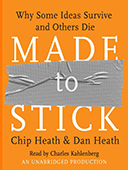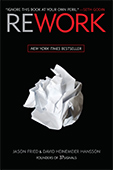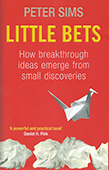Design Books That Are Not About Design
There are a couple of design classics that, it seems, almost everyone have read. You’ve probably read at least one of them: Design of Everyday Things, Don’t Make Me Think or Elements of Typographic Style. Maybe Universal Principles of Design. There’s a ton of topics that these books don’t cover, however, that are just as essential in your day-to-day work as a designer.
Design is about communicating, yet do you have any idea of how to communicate so that what you say is not instantly forgotten by others? Companies spend fortunes on marketing, yet regardless of how loud they shout, most fail to make a lasting impression. And, did you know that adding a single option to a choice—even to the most effortless choice, like choosing between two pens—can be enough to make people just bail out of deciding? These five books will help you expand your design thinking beyond just the appearance and interaction of things. They will teach about people’s irrational behaviour, how to communicate, and how design fits in your business.
Communicating
 In Made to Stick, Chip & Dan Heath explores what it is that makes some messages stick, and some disappear in the ocean of noise. In their own words, “In this indispensable guide, we discover that sticky messages of all kinds–from the infamous “kidney theft ring” hoax to a coach’s lessons on sportsmanship to a vision for a new product at Sony–draw their power from the same six traits.”
In Made to Stick, Chip & Dan Heath explores what it is that makes some messages stick, and some disappear in the ocean of noise. In their own words, “In this indispensable guide, we discover that sticky messages of all kinds–from the infamous “kidney theft ring” hoax to a coach’s lessons on sportsmanship to a vision for a new product at Sony–draw their power from the same six traits.”
 You might have seen Simon Sinek’s TEDx talk that went viral. If you haven’t, stop reading this right now and go see it. His book, Start with WHY, came out after his talk, and it explores in depth what is is that sets great leaders apart from everyone else: “They all think, act, and communicate in the exact same way-and it’s the complete opposite of what everyone else does. People like Martin Luther King Jr., Steve Jobs, and the Wright Brothers might have little in common, but they all started with why.”
You might have seen Simon Sinek’s TEDx talk that went viral. If you haven’t, stop reading this right now and go see it. His book, Start with WHY, came out after his talk, and it explores in depth what is is that sets great leaders apart from everyone else: “They all think, act, and communicate in the exact same way-and it’s the complete opposite of what everyone else does. People like Martin Luther King Jr., Steve Jobs, and the Wright Brothers might have little in common, but they all started with why.”
Decision Making
 Barry Schwartz’s TED talk has been seen over 4 and a half million times. The talk is modelled and named after his book, The Paradox of Choice, where he explores how “choice overload can make you question the decisions you make before you even make them, it can set you up for unrealistically high expectations, and it can make you blame yourself for any and all failures.” If you want better arguments why it’s vital to keep things simple, The Paradox of Choice is full of them.
Barry Schwartz’s TED talk has been seen over 4 and a half million times. The talk is modelled and named after his book, The Paradox of Choice, where he explores how “choice overload can make you question the decisions you make before you even make them, it can set you up for unrealistically high expectations, and it can make you blame yourself for any and all failures.” If you want better arguments why it’s vital to keep things simple, The Paradox of Choice is full of them.
The Big Picture
 Rework by Jason Fried and David Heinemeier Hansson is a no-bullshit business book, filled with practical advice accompanied by beautiful illustrations. In their own words, “Rework shows you a better, faster, easier way to succeed in business. Read it and you’ll know why plans are actually harmful, why you don’t need outside investors, and why you’re better off ignoring the competition. The truth is, you need less than you think. You don’t need to be a workaholic. You don’t need to staff up. You don’t need to waste time on paperwork or meetings. You don’t even need an office. Those are all just excuses.”
Rework by Jason Fried and David Heinemeier Hansson is a no-bullshit business book, filled with practical advice accompanied by beautiful illustrations. In their own words, “Rework shows you a better, faster, easier way to succeed in business. Read it and you’ll know why plans are actually harmful, why you don’t need outside investors, and why you’re better off ignoring the competition. The truth is, you need less than you think. You don’t need to be a workaholic. You don’t need to staff up. You don’t need to waste time on paperwork or meetings. You don’t even need an office. Those are all just excuses.”
 In Little Bets, Peter Sims explores how small bets leads to great breakthroughs; “What do Apple CEO Steve Jobs, comedian Chris Rock, prize-winning architect Frank Gehry, the story developers at Pixar films, and the Army Chief of Strategic Plans all have in common? Bestselling author Peter Sims found that all of them have achieved breakthrough results by methodically taking small, experimental steps in order to discover and develop new ideas.”
In Little Bets, Peter Sims explores how small bets leads to great breakthroughs; “What do Apple CEO Steve Jobs, comedian Chris Rock, prize-winning architect Frank Gehry, the story developers at Pixar films, and the Army Chief of Strategic Plans all have in common? Bestselling author Peter Sims found that all of them have achieved breakthrough results by methodically taking small, experimental steps in order to discover and develop new ideas.”
